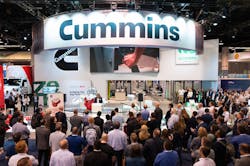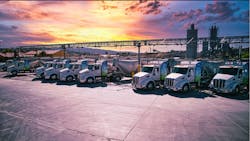Accelera by Cummins’ Davis stresses charging, refueling needs
ANAHEIM, California—Amy Davis, president of Accelera by Cummins, often reads that battery-electric commercial vehicles are ready or at cost parity for medium-duty trucks and regional applications. Those headlines make Davis scratch her head.
“While the math can add up, the practicality has some way to go,” Davis said during a May 3 keynote address at the Advanced Clean Transportation Expo here. “Infrastructure will play a key role in these choices, and that has yet to be seen.”
“There is a lot more that you need to think about than the technology,” she added. “Yet, we need to accelerate to reach zero emissions by 2050.”
The U.S. will need more than 1.2 million public charging stations and 28 million private charging locations by 2030 to meet federal emissions-reduction targets, Davis pointed out. She added that to realize the global potential, 660 million metric tons of renewable and low-carbon hydrogen will be needed by 2050.
See also: Experts detail building blocks of EV charging
“And it has to happen,” Davis said. “Our stakeholders expect it. Most people don’t think we’re moving fast enough, so I have three recommendations.”
Start with training people now, Davis advised, citing the significant complexities involved in electrification.
“I love that a lot of startups have entered this space and brought new ideas, but a lot of them do not know trucking and are naive to think that solutions that work for passenger cars will translate for commercial vehicles,” she explained. “We fundamentally believe they will not.”
Secondly, Davis said she urges industry stakeholders to invest in strategic infrastructure projects and partnerships. “One thing that is abundantly clear is that the amount of infrastructure in our country is insignificant,” she noted. “We need renewable energy sources for hydrogen and to power our charging stations, and we need access.”
Finally, Davis emphasized the importance of fleets piloting products and providing feedback to OEMs and suppliers to ensure new technologies will work within specific applications and duty cycles. “We also need demand,” she indicated. “Companies like us need to see the demand materialize.”
Accelera by Cummins products at ACT Expo
Two months ago, Cummins launched its Accelera zero-emission brand. This week during ACT Expo, Accelera showcased some of its product lineup, which puts strong emphasis on the role that hydrogen will play as part of Destination Zero, Cummins’ strategy to go further, faster to reduce greenhouse gas (GHG), and air-quality impacts of its products and reach zero emissions by 2050.
The brand's technologies across the hydrogen value chain include electrolyzers to produce hydrogen that can power both a hydrogen-fueled internal combustion engine (H2 ICE) concept truck and a fuel-cell electric powertrain.“To fully develop the hydrogen economy, we need to spur demand for hydrogen. We are developing a range of hydrogen solutions and believe H2-ICE powered trucks alongside wider adoption of fuel cell electric vehicles can help encourage development of hydrogen fuel infrastructure. In this way, hydrogen engines and fuel cells are complementary technologies, working together to drive the hydrogen economy forward,” explained Jennifer Rumsey, Cummins president and CEO. “At Cummins, we are actively scaling electrolyzer manufacturing, encouraged by the increased demand we are seeing. Electrolyzers are one of the key pieces of technology for green hydrogen production and will help decarbonize our economy and advance the clean energy transition.”
The hydrogen ecosystem is underpinned by green hydrogen production. Accelera’s electrolyzer technology aims to push forward the infrastructure scale-up needed to support hydrogen-powered vehicles, the company noted.
An electrolyzer splits water into oxygen and hydrogen, which can be used immediately or stored as a liquid or gas and transported. When powered by renewable electricity, like solar or wind, the hydrogen produced is carbon-free.
See also: NACFE report affirms hydrogen's major role in long-haul trucking's future
In addition, Accelera’s FCE150 Gen 4 fuel cell engine is available in 150 kW and 300 kW configurations with the flexibility to decarbonize a range of heavy-duty applications.
To complete the electric powertrain of an FCEV or a purely battery-electric vehicle, Accelera also provides a portfolio of batteries and electrified products. This includes a range of nickel manganese cobalt and lithium-iron phosphate technologies, including the BP107E.
“We have been innovating battery technology since 2017 and are now showcasing our third-generation design to give our customers the power and reliability they need to decarbonize their fleets,” Davis said.
Accelera also provides ePowertrain and traction systems in its electrified portfolio. The brand debuted its next-gen 14Xe ePowertrain, featuring increased power, peak torque and motor efficiency; the industry’s first hydraulic disc brake with integrated parking brake; and an eOptimized Twin Countershaft Transmission for enhanced compatibility with heavy-duty applications.
X15H Peterbilt Model 579 concept truck
During ACT Expo, Cummins also announced a heavy-duty concept truck featuring the X15H hydrogen internal combustion engine. The proof-of-concept installation with ratings up to 500 hp (372 kW) features a 700-bar pressure 80 kg high-capacity hydrogen storage system.
“The H2-ICE conversion highlights the opportunity for heavy-duty truck applications to operate on zero-carbon hydrogen fuel with an operating range of more than 500 miles,” according to the company. “The hydrogen conversion work is not expected to compromise truck performance, cargo capacity, or payload. The substitution of the diesel engine with the 15-liter hydrogen engine and integration with the existing driveline highlights the ability of H2-ICE to offer a zero-carbon solution for fleets to deploy quickly with limited investment.”
See also: Cummins is finding more than one way to decarbonize fleets
The X15H hydrogen engine with up to 1,900 lb.-ft. torque is an all-new engine platform featuring technology to enhance power density, reduce friction losses, and improve thermal efficiency. As a result, performance is equivalent to that of a similar displacement diesel engine and compatible with the same transmissions, drivelines, and cooling packages, according to Cummins.
“Our hydrogen engines also can help accelerate fleet decarbonization by offering familiar engine technology at a lower cost,” said Jim Nebergall, Cummins’ general manager of hydrogen engines.
Cummins begins field testing X15N CNG engine
Another announcement involving Cummins from this year’s ACT Expo is the company’s collaboration with the California Natural Gas Vehicle Partnership (CNGVP) to bring the X15N engine to market, including announcing that Cummins had begun field testing the engine with key fleet partners.
Cummins anticipates that starting in 2024, fleets will have the opportunity to order factory-built Class 8 trucks with the Cummins X15N 15-liter engine as Paccar has announced availability in both the Kenworth and Peterbilt brands. Designed as an economic and environmental sustainability solution for heavy-duty transport, the Cummins X15N engine will enable fleets to achieve a range of at least 750 miles even when hauling 82,000-lb. loads over challenging terrains.
See also: Mack reveals Granite CNG model with Cummins L9N engine
"With mounting environmental regulations and a focus on making progress toward corporate sustainability goals, fleet owners are making critical decisions about the future makeup of their fleets,” said Tom Swenson, manager of global regulatory affairs at Cummins and president of CNGVP.
“Class 8 trucks featuring the X15N engine are an attractive fleet sustainability option, as they offer fleets the closest direct replacement for diesel trucks in terms of operational performance. With the growing supply of carbon-negative renewable natural gas in California and the reintroduction of the Alternative Fuel Tax Credit, fleets have an incredible opportunity to reduce both their environmental impact and overall operating costs.”
During CNGVP’s 2023 ACT Expo press conference, Cummins shared that it would deliver 25 Class 8 trucks upfit with the X15N engine for fleet field tests. Through September, the X15N engine technology will be demonstrated across a variety of applications, terrains, and locations throughout the U.S., providing Cummins with real-world operating data that will be used to validate its commercial production plans. California fleets taking part in the field tests include National Ready Mixed Concrete Co., Walmart, Matheson, Food Express, and Sandman.
“When looking across a variety of factors including range, fueling frequency and speed, hauling capacity, and maintenance support, we believe that trucks with the X15N engine will hold up to diesel trucks better than any other commercially available low-emission vehicle technology,” said Steve Lode, president of National Ready Mixed Concrete. “Additionally, the utilization of RNG provides the only available fuel source technology to achieve massive reductions in our GHG emissions, an extremely critical objective of our company. RNG also offers us the best opportunity to keep our costs down when compared to diesel and other alternative fuels.”
RNG consumed by vehicles in California—which is produced from a variety of organic and renewable sources, including wastewater treatment plants, food and green waste, landfills, dairies, and more—had an energy weighted average carbon intensity of minus-87.74 gCO2e/MJ for calendar year 2022, according to California's Low Carbon Fuel Standard program data reported on April 28.
Several federal tax credits are available to help fleets benefit from utilizing natural gas fuel, including the recently reauthorized Alternative Fuel Tax Credit of 50 cents per gallon passed as part of the Inflation Reduction Act in 2022. Under the IRA, a Clean Fuel Production Credit of roughly $1 per gallon also was created to reduce the cost of producing natural gas for fleets.
About the Author

Cristina Commendatore
Cristina Commendatore is a past FleetOwner editor-in-chief. She wrote for the publication from 2015 to 2023.


